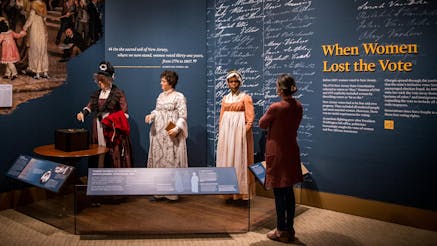Search Results

Women's History Month
Women's History Month Book Features
Finding Freedom: Andrew - Record of Marriage
Andrew Ferguson married Jenny (or Jinny) Murphey in Monroe County, Indiana, in 1844. According to the 1850 United States Census for Monroe County, Jenny (listed on the census as Jane Ferguson) was born in Maryland.
Monroe County History Center Collection, Bloomington, IN
Season of Independence: Charlestown, South Carolina Grand Jury Presentments, April 23, 1776
This documentation of Grand Jury Presentments in Charlestown, South Carolina makes numerous legal arguments for why South Carolina and other American colonies would be justified in dissolving their connection to Great Britain. Also included are various grievances against King George III and Parliament, similar to those that were later included in the Declaration of Independence when it was adopted by Congress.
Courtesy of South Carolina Department of Archives and History
Cost of Revolution: Part 3 Wounded Veteran
The Davenport Letters: January 15, 1783
James wrote another letter home about a month after his mess finished their winter hut in the encampment at New Windsor, New York. The army remained largely inactive and unpaid, or, as Davenport put it, in “peace and Poverty,” leading to ongoing frustrations among the soldiery. While many Continental soldiers had a deep ideological commitment to the Revolution and had served for years, they also felt, as Davenport put it, that “the Labourer is worthy of his hire.”
The Davenport Letters: June 26, 1782
The letters James Davenport wrote from West Point in May and June of 1782 were just over a month apart, suggesting that he probably wrote more letters home than survive in this set. Little had changed in his circumstances, however, and the soldiers still had “Plenty of duty & Little Provision & less money.” Davenport’s humor comes through in this letter, and it includes facetious remarks about the quality of his paper, young women at home, and the oppressive summer weather.
Finding Freedom: London - Robert Pleasants’s Letter to Benedict Arnold
On January 30, 1781, London’s former owner, Robert Pleasants, wrote this letter to British Brigadier General Benedict Arnold, the American turncoat. Pleasants described how he valued London and wanted him to be returned. Soldiers from Arnold’s army had encamped near Pleasants’s plantation, called “Curles Neck,” earlier that month and may have persuaded London and his uncle, Carter Jack, to join them. London never returned to the Pleasants’s plantation.
Robert Pleasants Letterbook, Special Collections Research Center, Swem Library, College of William and Mary
The Davenport Letters: January 15, 1778
The Continental Army had been at Valley Forge, Pennsylvania, for less than a month when Sergeant Isaac How Davenport wrote home to his brother, Samuel, in Dorchester, Massachusetts. Isaac had joined the Continental Army shortly after Lexington and Concord and served as a member of General George Washington’s Commander in Chief’s Guard. A company of mounted Guardsmen were commanded by Captain George Lewis, Washington’s nephew. In early 1777, they were consolidated into the 3rd Regiment of Continental Dragoons commanded by Colonel George Baylor. Davenport served as a sergeant through the campaigns of 1777 with this regiment. In this letter, he reflects on conditions at Valley Forge in early 1778. James and Isaac had three other brothers, Josiah, Joseph, and Samuel.
Finding Freedom: Deborah - George Washington’s Letter to Lund Washington
On April 30, 1781, General George Washington wrote this letter to Lund Washington, his cousin and farm manager, to express his disgust with Lund Washington’s decision to supply the British when they came to Mount Vernon earlier that month. In General Washington’s absence, Lund Washington convinced the British to spare the plantation from being destroyed by providing them with food and supplies. General Washington wrote in response, “It would have been a less painful circumstance to me, to have heard…they had burnt my House, & laid the Plantation in Ruins.” Lund Washington’s negotiation saved the property, but General Washington felt his honor had been tarnished by giving in to the enemy. The departure of 17 enslaved people, including Deborah, only worsened Washington’s embarrassment. Although the British left Washington’s plantation untouched, they burned many neighboring properties.
George Washington Papers, Manuscript Division, Library of Congress, Washington, DC